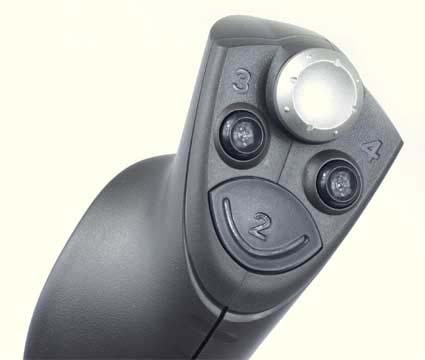Joysticks For Flight Simulation: Using A Lever To Fly A Plane!
Microsoft Sidewinder Precision 2
The Sidewinder was the first joystick designed for flight simulation. That's not surprising, given that it was made by Microsoft, the company responsible for the Flight Simulator program. Microsoft is also responsible for the principle of a rudder that works by rotating the shaft on its axis. Precision 2 is the latest addition to the range, with a price somewhere in the vicinity of $45. The uncluttered design leaves an exemplary impression of quality and finish. This joystick is virtually indestructible. It has a slightly grainy texture that has a very pleasant feel, and the ergonomic design of the shaft offers a very good grip (for right-handed users only). The position of the buttons and of the directional hat on the top of the shaft is ideal. It's just a pity that they are slightly tacky in comparison to those used on the previous model. They are ergonomically perfect, because the hat and three buttons can be operated without unduly stretching your thumb.
Precision 2 has eight buttons - four on the base and four on the top of the shaft. All are numbered, which makes it easy to identify them. The shaft movement is perfect, being long enough and steady enough to guarantee maximum precision. To make it as accurate as possible, Microsoft uses optical detectors rather than a potentiometer. The same applies to the rudder bar. Only the throttle handle lacks the same firmness. The joystick is sufficiently stable on its base.
To install Precision 2, you will need to use a driver, provided on a CD. The problem is that Microsoft's drivers are not unified, so you could find yourself with two versions of the software installed on your PC if you happen to own a lot of Sidewinder peripherals. Furthermore, you will be forced to install a program manager for programming the buttons, which puts an icon onto the task bar. In Windows ME and on certain makes of PCs, this could even cause a conflict between various versions of the driver and the peripherals, which seems rather silly when you consider that the Windows developers and the Sidewinder programmers work right next door to each other! That said, most of the time, the joystick operation presents no problems. Once the driver has been installed, Precision 2 is automatically recognized by the system and does not need adjusting. When running under Windows 2000 and XP, it is as easy as pie. The joystick is recognized automatically and no driver installation is required. In conclusion, Precision 2 is particularly well suited for use with flight simulators. It is absolutely precise and has excellent ergonomics.
Get Tom's Hardware's best news and in-depth reviews, straight to your inbox.
Current page: Microsoft Sidewinder Precision 2
Prev Page The Protagonists Next Page Saitek Cyborg 3D Gold
